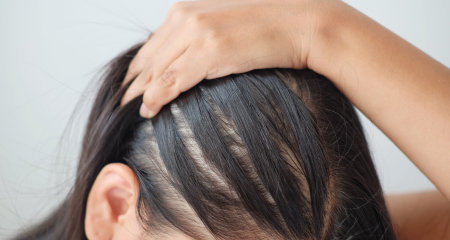
Finding an unexpected bald spot or experiencing a sudden loss of eyelashes can be alarming. This kind of unexpected hair loss, whether it affects you or someone close to you, could be a sign of alopecia. At Northstar Dermatology in Colleyville, our skilled dermatologists will diagnose the presence of alopecia, develop a personalized treatment plan focused on regrowth, and prevent further hair loss. If alopecia is impacting your self-esteem and overall well-being, don’t hesitate to seek expert treatment. Contact us directly by phone or book an appointment online.
Alopecia is a medical term encompassing any form of hair loss. Often, people mistake “alopecia” for alopecia areata, a specific type of hair loss that appears due to an autoimmune reaction targeting hair follicles. However, general alopecia isn’t a singular condition; it can occur due to hereditary factors, disease, or other underlying causes.
Alopecia comes in two main varieties that are usually classified as scarring and non-scarring hair loss.
Scarring hair loss: This variant is less common and usually results from an immune reaction against hair follicles. It can cause symptoms like redness, scaling, itching, or burning on the scalp. Over time, the hair follicles are destroyed, leading to scar tissue formation and permanent hair loss.
Non-scarring hair loss: The far more common of the two, this form includes conditions like telogen effluvium and androgenetic (hereditary) hair loss. Telogen effluvium involves widespread hair shedding following significant physical stress, such as severe infection, chronic illness, surgery, major weight loss, or childbirth. This type of hair loss typically begins around three months after the triggering event and lasts about six months. Most individuals will experience full regrowth.
Hereditary or androgenetic hair loss is extremely prevalent, influenced by genetics and individual responses to androgen hormone levels. It affects up to 80% of people to some degree, although the onset, rate, and severity of hair loss vary widely.
Before beginning any treatment for hair loss, it’s essential to consult with a healthcare provider. A thorough examination and potential lab tests can help identify or rule out any health conditions that may be contributing to hair loss.
For hereditary alopecia, several treatment options are available. An effective over-the-counter option is minoxidil 5% foam or liquid, commonly sold under the brand name Rogaine. Applied once or twice daily, this treatment can start to show results in up to six months, although some initial shedding can occur. Prescription-strength minoxidil is also available from a dermatologist and works by thickening existing, finer hairs, making the scalp look fuller. Recently, oral minoxidil has been introduced as another viable option.
For some, oral medications are one of the best ways to manage hair loss. Spironolactone, commonly used for female pattern hair loss, works by lowering androgen levels. Other options, including finasteride and dutasteride, are effective for both men and women, blocking the androgen effects that can contribute to hair loss. For more severe cases of alopecia areata, medications like tofacitinib, olumiant (baricitinib), and litfulo (ritlecitinib) have been studied and found to be effective treatments. Although generally safe, these medications do have side effects, which should be discussed with your physician.
Corticosteroid injections directly into thinning or balding areas can also stimulate regrowth. Multiple treatments, usually spaced 4–8 weeks apart, are often required for noticeable results.
The way we look plays a significant role in our self-image, so hair loss is an understandably sensitive issue. Unfortunately, many companies exploit these concerns, often selling costly products that are ultimately ineffective. Whatever steps are taken, it’s important to maintain realistic expectations. There’s no instant fix, and it may not be possible to completely reclaim your hair’s youthful thickness. However, advancements in research and treatments for hair loss are continually evolving, offering more promising options than ever before. As always, explore treatments safely and with confidence by seeking out the support of board-certified dermatologists.
